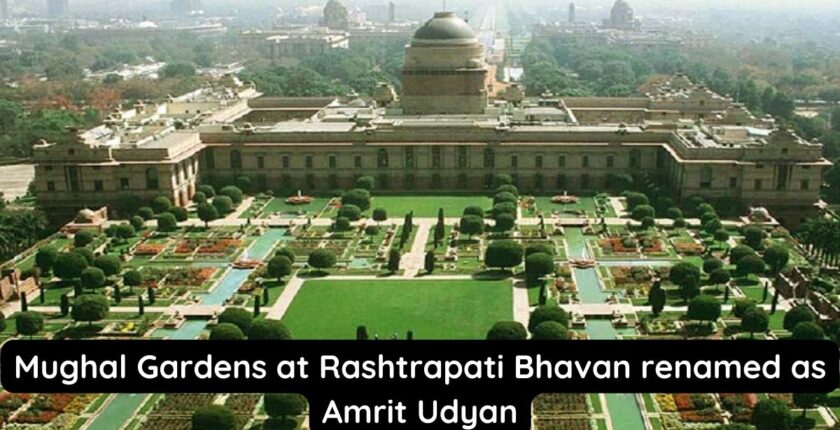New Article
Mughal Gardens at Rashtrapati Bhavan renamed as Amrit Udyan
- January 28, 2023
- Posted by: Admin
- Category: Person and Places in News Art & Culture Current Affairs Indian Nation and State Current Affairs MPPSC State PSC Exams

- Mughal Gardens at Rashtrapati Bhavan renamed as Amrit Udyan
- Amrit Udyan opening date 2023
- Amrit Udyan Online ticket booking
- Guidelines For The Amrit Udyan
- History of Mughal Gardens Design
- Features of Mughal Gardens Design
- List of Mughal Garden Design Sites found in the World
- Afghanistan
- Bangladesh
- India
- Jammu and Kashmir
- Pakistan
- Frequently Asked Questions:
- Who built Mughal Garden in Rashtrapati Bhavan?
- Why is Mughal Garden famous?
- What are the main features of the Mughal Garden?
- Which type of garden is present in Rashtrapati Bhavan?
- Who built the first Mughal garden in India?
- Which is the oldest Mughal Garden in India?
Mughal Gardens at Rashtrapati Bhavan renamed as Amrit Udyan
The Mughal Garden in Rashtrapati Bhavan has been renamed “Amrit Udyan” by the Central Government. The choice was made on Saturday, January 28th, in keeping with the Azadi Ka Amrit Mahotsav, a government of India endeavour to honour and remember 75 years of independence as well as the illustrious past of its people, culture, and accomplishments.
The newly renamed garden will reportedly be opened by President Droupadi Murmu on Sunday, January 29. The Rashtrapati Bhavan gardens have been given the common name “Amrit Udyan” by the President of India in honour of the 75th anniversary of the country’s independence, according to Navika Gupta, the president’s deputy press secretary.
President Droupadi Murmu will grace the opening of the Amrit Udyan tomorrow. https://t.co/4rXOMlZXA3 pic.twitter.com/7WhgilMoWW
— President of India (@rashtrapatibhvn) January 28, 2023
The garden, which is a stunning fusion of Mughal and British designs, is situated on the grounds of the President of India’s official house. The location, designed by British architect Sir Edwin Lutyens for Lady Harding, features a vibrant exhibition of various flora types.
This 15-acre garden, which is home to hundreds of different flower kinds, is open to the public once a year in the months of February and March.
Amrit Udyan opening date 2023
The “Amrit Udyan” gate will be accessible to the general public on February 12, 2023. According to the PM Modi Yojana’s official website, the gate will close on March 16, 2023. You can purchase tickets online to the garden.
Amrit Udyan Online ticket booking
- First, go to the official website of Amrit Udyan ticket booking http://rashtrapatisachivalaya.gov.in/rbtour/
- You will find three circuits of travelling. You have to select Mughal Garden Visit (During Udyanotsav)
- After that, you have to Fill out the required details like Name, Date of visit, etc.
- Then Registered yourself by submitting your photo id.
- You were not asked for a fee under the registration process.
- Please note that same-day registration is not allowed, register at least one day before the visit date.
Guidelines For The Amrit Udyan
- The Amrit Udyan will open on February 12, 2023, and close on March 16, 2023.
- To visit, you must first register on the official website within 24 hours. Registration on the same day is not permitted.
- Visit Rbtour/Mughal-Garden/ to sign up. Find out here how to register.
- As Amrit Udyan is closed on Mondays, you cannot visit on that day.
- The remaining days, such as Sunday, Tuesday, Wednesday, Thursday, Friday, and Saturday, are open for visits.
- Due to security concerns, a camera cannot be carried but a mobile phone can.
History of Mughal Gardens Design
The Mughals created a specific kind of garden known as a Mughal Garden. The Persian gardens, in particular the Charbagh structure, which aims to create a portrayal of an earthly utopia in which humans live in perfect harmony with all other aspects of nature, had an impact on this design.
Features of Mughal Gardens Design
- Within the walled enclosures, rectilinear layouts are heavily utilised.
- Inside the gardens, common features include canals, ponds, and fountains.
- Numerous gardens in Afghanistan, Bangladesh, and India deviate from their Central Asian forebears in terms of “the extremely disciplined geometry.”
Mughal garden design is primarily influenced by the mediaeval Islamic garden, while there are nomadic elements from the Mughals’ Turkish-Mongolian ancestors.
The Mughals were symbol-obsessed and found numerous ways to incorporate them into their gardens. The traditional Quranic allusions to paradise were found in the design, arrangement, and type of vegetation; however, extra secular allusions, such as numerological and zodiacal significances linked to ancestry or other cultural signification, were frequently contrasted. The Mughals believed the numbers eight and nine to be lucky, which is why there are so many terraces and octagonal pools in garden architecture.
List of Mughal Garden Design Sites found in the World
Afghanistan
- Bagh-e Babur, Kabul
Bangladesh
- Lalbagh Fort
India
Delhi
- Humayun’s Tomb, Nizamuddin East
- Qudsia Bagh
- Rashtrapati Bhavan (neo-Mughal)
- Red Fort
- Roshanara Bagh
- Safdarjung’s Tomb
- Shalimar Bagh, Delhi
Haryana
- Pinjore Gardens
Jammu and Kashmir
- Naseem Bagh
- Achabal Gardens
- Chashma Shahi
- Nishat Bagh
- Pari Mahal
- Shalimar Bagh, Srinagar
- Verinag
Karnataka
- Lal Bagh, Mysore-era Mughal style gardens
- Brindavan Gardens (neo-Mughal)
Maharashtra
- Bibi Ka Maqbara, Aurangabad
Punjab
- Aam Khas Bagh
Rajasthan
- Jahangir’s gardens at Ana Sagar Lake
Uttar Pradesh
- Agra Fort
- Akbar’s Tomb
- Khusro Bagh, Allahabad
- Mehtab Bagh, Agra
- Taj Mahal
- Tomb of I’timād-ud-Daulah
- Tomb of Mariam-uz-Zamani
- Zenana gardens at Fatehpur Sikri
Pakistan
- Chauburji
- Gulabi Bagh
- Hazuri Bagh, Sikh-era charbagh style gardens
- Hiran Minar, Sheikhupura
- Quadrangle gardens at Lahore Fort
- Shahdara Bagh
- Shalimar Gardens, Lahore
- Tomb of Asif Khan
- Tomb of Jahangir
- Wah Gardens
Read More: MPPSC Free Study Material (English/Hindi)
🤩Follow Our Social Media Handles
YouTube 👉 https://bit.ly/36wAy17
Telegram👉 https://bit.ly/3sZTLzD
Facebook 👉 https://bit.ly/3sdKwN0
Daily Current Affairs Quiz for UPSC, MPSC, BPSC, and UPPSC: Click here
Frequently Asked Questions:
Who built Mughal Garden in Rashtrapati Bhavan?
Sir Edwin Lutyens had finalized the designs of the Mughal Gardens as early as 1917, however, it was only during the year 1928-1929 that plantings were done. His collaborator for the gardens was Director of Horticulture, William Mustoe.
Why is Mughal Garden famous?
The fountains and water-chutes of Mughal gardens represented the resurrection and regrowth of life, as well as to represent the cool, mountainous streams of Central Asia and Afghanistan that Babur was famously fond of.
What are the main features of the Mughal Garden?
Mughal gardens feature canals and pools along the axes, as well as fountains and waterfalls.
Which type of garden is present in Rashtrapati Bhavan?
Swami Vivekanand Garden or Amrit Udyan is a Mughal Garden situated at the back of the Rashtrapati Bhavan, incorporate both Mughal and English landscaping styles and features a great variety of flowers. The Rashtrapati Bhavan gardens are open to the public in February every year.
Who built the first Mughal garden in India?
The Rambagh ( Aram Bagh ) was the first of the Mughal Gardens of India, built by Babur in 1528.
Which is the oldest Mughal Garden in India?
The Aram Bagh is the oldest Mughal Garden in India, originally built by the Mughal Emperor Babur in 1528, located about five kilometers northeast of the Taj Mahal in Agra, India. Babur was temporarily buried there before being interred in Kabul.

